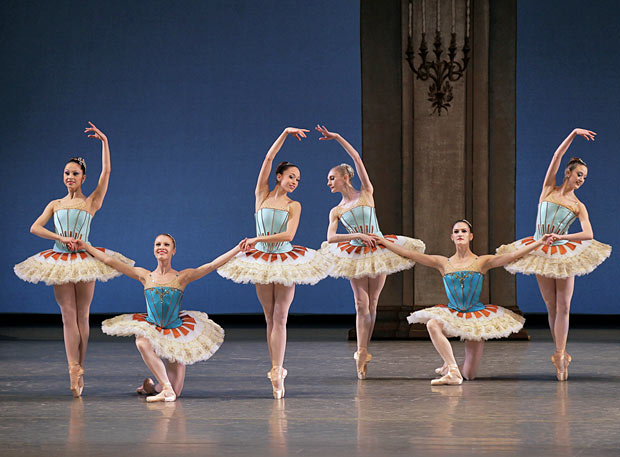
© Paul Kolnik. (Click image for larger version)
New York City Ballet
Swan Lake, Allegro Brillante, Tschaikovsky’s Suite No. 3
Washington, Kennedy Center Opera House
31 March 2013
www.nycballet.com
www.kennedy-center.org
George Balanchine understood the musical sensibilities and creative temperament of Pyotr Ilyich Tchaikovsky (1840-1893) like no other choreographer. His ballets set to the music of the Russian composer amplified the drama, tension and excitement of the music and thus made it possible for audiences to enjoy and appreciate Tchaikovsky in an entirely new light.
The revitalizing impact of Balanchine’s choreography on Tchaikovsky’s music was particularly evident in the all-Tchaikovsky, all-Balanchine program presented by New York City Ballet at the Kennedy Center Opera House during the last week of March.
Each of three ballets I saw during the Sunday matinee performance – Swan Lake, Allegro Brillante, and Tschaikovsky’s Suite No. 3 – not only provided the audience with the extraordinary experience of watching a Balanchine ballet, but also enhanced their perception and grasp of Tchaikovsky’s music.
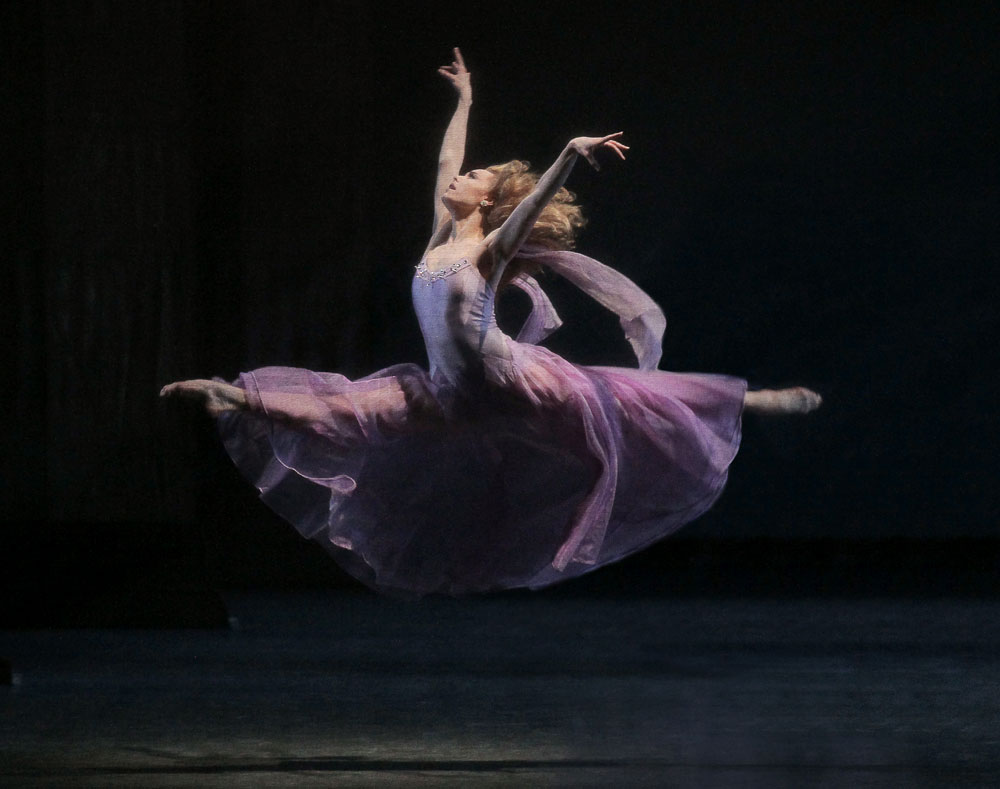
© Paul Kolnik. (Click image for larger version)
Swan Lake was the first of Tchaikovsky’s three ballets. A masterpiece in its own right, the score set a new high standard in the creation of music for dance, elevating ballet to the level of dramatic theater. In 1875 Tchaikovsky, in a letter to Rimsky-Korsakov, confessed: “I accepted the work partly because I need the money, and because I long cherished a desire to try my hand at this type of music.”
Like Tchaikovsky, Balanchine created his one-act Swan Lake with a revenue stream in mind. In 1951 his three-year old company was struggling financially and needed a boost. Morton Baum, then-president of City Center, convinced the choreographer to stage a short version of Swan Lake to attract wider audiences to the theater. Balanchine did so, albeit with a slight reluctance and only after he was assured that he would be allowed to mount “a more daring piece in the future.” (Three years later, for the same financial reason, Baum asked Balanchine, “George, do Nutcracker,” but that’s another Balanchine-Tchaikovsky story.)
For those familiar with the evening-long, four-act production of Swan Lake, Balanchine’s highly abbreviated version may seem rather peculiar. In it, the choreographer used the music and the concept from the two lakeside acts (Act II and Act IV) of the Ivanov-Petipa production for the Mariinsky Ballet, which the renowned Russian troupe premiered in St. Petersburg in 1895.
In this 35-minute ballet, Balanchine kept the essential narrative intact while discarding the sub-plots and mime scenes, magnifying the tragic love story of the bewitched princess Odette and Prince Siegfried. As Edwin Denby aptly described the production: “…acting or no acting, it was the drama of the story that Balanchine saved.”
Balanchine changed his choreography for Swan Lake over the years, reshaping the dances for the principals and expanding the role of the corps de ballet. The resulting work draws the audience closer to the heart of Tchaikovsky’s brilliant score, revealing wonders and dramatic possibilities of the ballet’s enchanting “lakeside” music.
The most puzzling twist in the current NYCB version of Swan Lake is its post-Balanchine décor: the icy landscape scenery of the lake and black tulip-shaped dresses for the 30-bird flock of swan-maidens, which piercingly set them apart from Odette, who wears a traditional white classic tutu. (The winter-inspired stage decorations and the mournful costumes for the corps, designed by Alain Vaes, replaced the original Gothic lakeside vistas and all-white swan tutus when the production was redesigned in 1986, three years after Balanchine’s death.)
As Odette, Maria Kowroski played down the role’s dramatic side, opting for the display of pure dancing. While her dancing looked technically strong, yet theatrically underpowered, the performance of Tyler Angle in the role of Prince Siegfried lifted the ballet to a truly sublime level. Angle captured Siegfried’s hopes, desires, and his ultimate loss, all that and more. He was poignant even in the moment of stillness, when, at the end, on the verge of despair, he hopelessly watched a white swan float by before his eyes, realizing that his love was lost, lost forever.

© Paul Kolnik. (Click image for larger version)
Unlike Tchaikovsky’s first and second piano concertos, his Piano Concerto No. 3 in E-flat Major, with its fragmented solo movement that seeks but rarely finds cohesion, is rarely performed in concerts. The concerto was originally envisioned as the opening movement of what was supposed to be his sixth symphony, but the composer wasn’t entirely satisfied with this work and left it unfinished, only to return to the piece a year later and rework it into a composition for piano and orchestra. Titled Allegro Brillante, this single-movement piano concerto was Tchaikovsky’s final completed work, published and premiered only after the composer’s death. In 1956 Balanchine used this concerto for his new ballet, Allegro Brillante, with Maria Tallchief in the leading ballerina role.
Watching Balanchine’s Allegro Brillante, it’s hard to believe that this sunny and effervescent ballet is set to the music composed by a depressed and supposedly suicidal man, for this fascinating dance bursts with boundless vigor and excitement. It’s a pure classical dance and a vivid example of Balanchine’s classical aesthetic. Its intricate, high-velocity choreography reveals the infinite technical and dramatic potential inherent in classical ballet. It encapsulates the choreographer’s passion and knowledge of Tchaikovsky’s music and allows the audience to hear and experience Tchaikovsky afresh.
In this relatively short piece, which lasts a little more than 15 minutes, Balanchine brought to the fore the robust energy and playful lyricism of the score, creating a glittering and joyful showpiece for ten dancers (a principal couple and a four-couple ensemble) to demonstrate once again that Tchaikovsky’s music was destined for dancing.
On Sunday Tiler Peck dazzled in the ballerina role, meeting the challenges of speed, clarity and brilliance required in the choreography. She is a highly virtuosic and yet very insightful dancer, and every moment of her performance was one to cherish. I especially marveled at her evanescent solo, in which her vigorous, polished dancing aptly mirrored the wild piano rush in the cadenza. Amar Ramasar was her fluent and assured partner.
The four supporting couples opened the ballet, and over the course of the piece hardly had a moment of rest – the choreography for the corps is as demanding and virtuosic as that for the principal couple. The terrific ensemble excelled at every turn, conquering the increasingly challenging choreography, full of brisk, light leaps and fast turns, dancing with fine phrasing and impeccable timing. The entire cast seemed to be having fun, and this feeling was utterly contagious.
One can look at Balanchine’s Tschaikovsky Suite No. 3 as a suite of two independent ballets or as a four-part ballet that reflects the shifting mood of its underlying score – Tchaikovsky’s Orchestral Suite No. 3 in G, Op. 55.
Just like Tchaikovsky’s third piano concerto, his Suite No. 3 was originally conceived as a symphony. The suite consists of four movements, with the final Tema con Variazioni longer than the first three movements combined. It was this glorious finale that attracted Balanchine the most; and in 1947, he used it to create a ballet called Theme and Variations for American Ballet Theatre (then Ballet Theatre). An exhilarating showcase of classicism in all its elegance and splendor and a tribute to his Russian heritage, the ballet is considered one of Balanchine’s finest works. In 1970, the choreographer returned to the Tchaikovsky suite and added the first three movements to Theme and Variations to create a larger ballet, this time for his own company, New York City Ballet. The new four-section piece was titled, after its music, Tschaikovsky Suite No. 3.
Reflecting the poignant lyricism of the suite’s first three movements, Balanchine adorned his new sections with a melancholic Romantic feel. The dark scrim, separating the stage from the audience, gives the ballet’s ballroom a somber, haunted look; and the ballerinas in long tulle frocks, with their hair unbound, evoke alluring, voluptuous sirens.
The opening scene of the ballet, Élégie, hints at a story of thwarted love. At its heart is a soulful poet (the poignantly noble Ask la Cour) who searches for and ultimately loses the woman of his dreams (the rapturous Teresa Reichlen). Elusive and serene, she is his ideal vision of love. He keeps reaching for her but each time she softly slips away from his grasp as if being pulled away by a mysterious force.
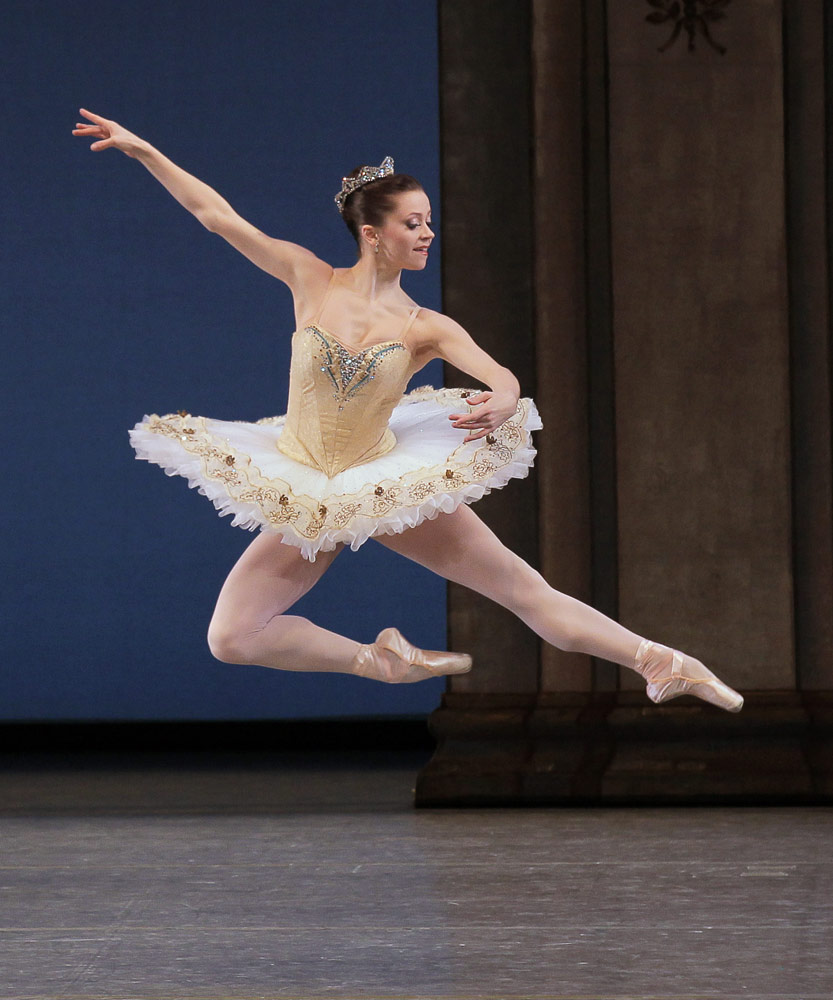
© Paul Kolnik. (Click image for larger version)
The sentimental Valse Mélancolique (danced by Abi Stafford and Jared Angle) and the whirling Scherzo (with Erica Pereira and Daniel Ulbricht as the leading couple) also take place in the dreamy, otherworldly realm established in the opening movement; but the atmosphere of doom and melodrama suddenly changes when the scrim goes up on the ballet’s final Tema. The transformation is striking – I felt like I was watching a totally different ballet. The stage is flooded with bright light, the ballroom chandeliers sparkle with brilliance, the ballerinas dressed in stunning tutus astound with their glamorous comportment and the classical ballet tradition takes the reins. If the first three movements allude to a dark and mysterious underworld, the ballet’s gorgeous finale offered a vision of heaven. This magnificent makeover experience was amplified by the fine performance of the 26-member cast, admirably led by Megan Fairchild and Andrew Veyette. Tema proved the perfect showcase for the company’s bright talents.












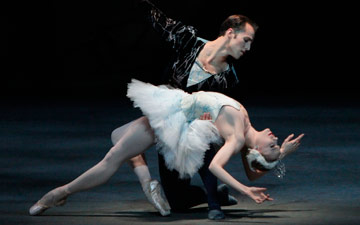



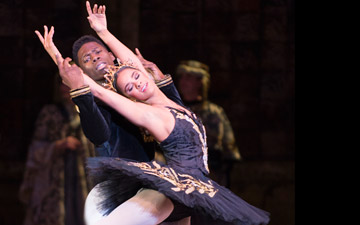
You must be logged in to post a comment.